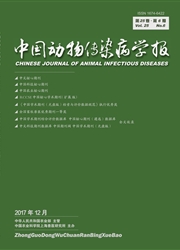

 中文摘要:
中文摘要:
循环性microRNAs不仅参与生命体的重要活动调控,还有望成为某些疾病诊断的新型标志分子。为深入探讨宿主与血吸虫之间的相互作用机制并发现新型诊断标志分子,我们对前期获得的感染和未感染新西兰大白兔血浆小RNA的Solexia测序结果进行生物信息学分析,对差异表达的microRNAs用实时定量PCR进行验证,同时对这些差异表达的microRNAs的靶基因进行了分析。在剔除虫源性序列后,我们发现了感染和未感染日本血吸虫的新西兰大白兔体内的循环性宿主源microRNAs 173条,选取了10个差异表达的microRNAs利用实时定量PCR进行验证分析,结果表明所选取的10个microRNAs表达与Solex测序结果一致。靶基因的预测与分析结果表明感染血吸虫兔血浆中差异表达microRNAs的靶基因主要参与细胞进程、代谢调控、生命调控、发育进程等生命进程调控。本研究结果为深入开展日本血吸虫与宿主的互作及其寄生的分子机理提供了基础。
 英文摘要:
英文摘要:
Circulating micro RNAs are not only involved in the regulation of many life processes, but also considered to be a novel class of biomarkers for diagnosis of diseases. To better understand the interaction mechanisms between hosts and Schistosoma japonicum, the micro RNA populations in infected New Zealand rabbits were further analyzed based on our previous Solexia data from infected and uninfected rabbits. Total 173 rabbit micro RNAs associated with Schistosoma japonicum infection were obtained, from which 10 micro RNAs different between infected and uninfected rabbits were verified in a q RT-PCR. Bioinformatical analysis also indicated that the target genes of these altered micro RNAs were putatively involved in many biological processes such as cellular process, metabolic process, biological regulation, developmental process and catalytic activity. The results obtained here provided a basis for further research on interaction between hosts and schistosomes.
 同期刊论文项目
同期刊论文项目
 同项目期刊论文
同项目期刊论文
 期刊信息
期刊信息
